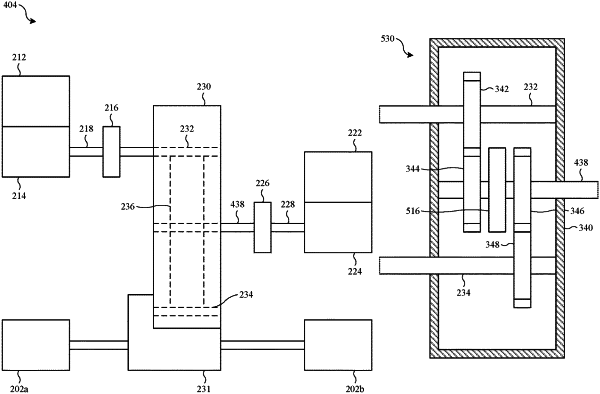| CPC B60L 15/2054 (2013.01) [B60K 1/02 (2013.01); B60K 17/02 (2013.01); B60K 17/04 (2013.01); B60L 50/51 (2019.02); B60L 50/60 (2019.02); H02P 5/747 (2013.01); B60K 17/165 (2013.01); B60L 2210/40 (2013.01); B60L 2220/42 (2013.01); B60L 2240/12 (2013.01); B60L 2240/50 (2013.01); B60L 2260/20 (2013.01)] | 18 Claims |

|
1. A propulsion system, comprising:
one or more batteries that output direct current electrical power;
a first inverter that receives the direct current electrical power from the one or more batteries and generates a first alternating current electrical power output;
a first electric motor that is configured to be operated by the first alternating current electrical power output from the first inverter to rotate a first motor output shaft to provide a first input torque;
a second inverter that receives the direct current electrical power from the one or more batteries and generates a second alternating current electrical power output;
a second electric motor that is configured to be operated by the second alternating current electrical power output from the second inverter to rotate a second motor output shaft to provide a second input torque;
a gearbox that includes a gearbox input shaft, a gearbox output shaft, and an intermediate shaft, wherein the gearbox input shaft receives the first input torque from the first motor output shaft of the first electric motor, the intermediate shaft receives the second input torque from the second motor output shaft of the second electric motor, and the gearbox output shaft rotates to provide a gearbox output torque in response to the first input torque and the second input torque; and
a first disconnect device located on the intermediate shaft that is configured to move between an engaged position in which the gearbox input shaft is mechanically coupled to the gearbox output shaft and a disengaged position in which the gearbox input shaft is not mechanically coupled to the gearbox output shaft, a second disconnect device that moves between an engaged position in which the second motor output shaft is connected to the intermediate shaft of the gearbox so that rotation of the second motor output shaft provides the second input torque to the gearbox, and a disengaged position in which the second motor output shaft is disconnected from the intermediate shaft of the gearbox so that rotation of the second motor output shaft does not provide the second input torque to the gearbox,
wherein the first electric motor has a higher energy efficiency in a first operating range as compared to a second operating range, and the second electric motor has a higher energy efficiency in the second operating range as compared to the first operating range.
|